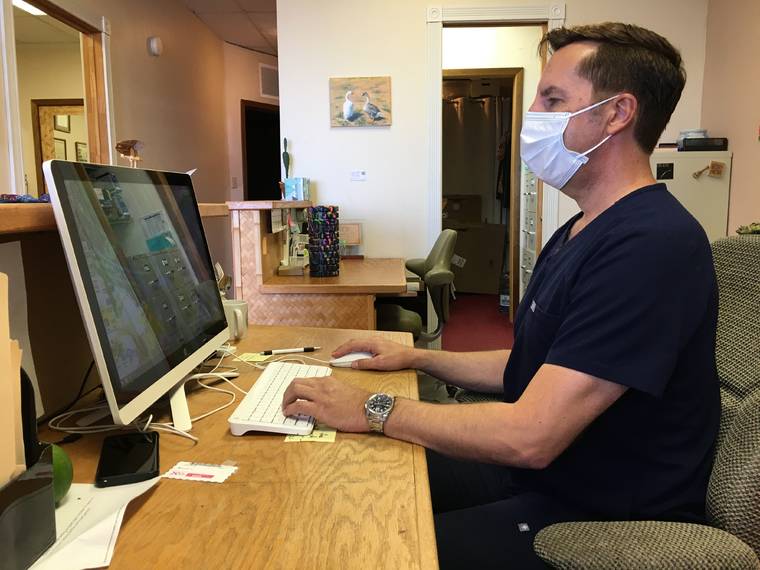It’s no surprise that neck, shoulder, and back pain are common complaints among athletes who are constantly training and racing as they push their bodies to the limit. Just ask anyone who has taken a six-hour bike ride to Hawi about the stiffness and soreness they feel afterwards. How about a distance swimmer or a runner training for a marathon?
Yes, we all know the feeling. While having a proper bike fit, stretching and daily foam rolling can help to alleviate common nagging symptoms, most still end up seeing a professional like a chiropractor, massage and physical therapist for relief.
Now, with more people having increased screen time to work, learn and communicate remotely due to COVID-19, these very same symptoms — neck, shoulder and back pain — have caused an uptick in the number of patients walking through the door of Dr. James Stanley’s quaint chiropractic office. And I am one of them.
I have been seeing Dr. Stanley for more than a decade to treat various imbalances associated with running and riding my bike. However, over the last three weeks my visits have been linked to symptoms primarily caused by a drastic increase in sitting while viewing a laptop screen.
I caught up to the busy doctor who kindly shared some sound advice on how to improve one’s virtual setup at home or in the office, the importance of allowing your eyes frequent breaks from the screen, and the benefits of exercise to improve mood and motivation.
Q: With more people having to work, learn, and communicate virtually on a daily basis due to COVID-19, what physical ailments do you find are common among teleworkers?
I find that with the COVID -19 pandemic I am seeing a much greater incidence of posture and stress related musculoskeletal complaints in my practice. Common ailments such as headaches, carpal tunnel, piriformis syndrome, sciatica, chronic hip flexor shortening are definitely increased. Upper neck, upper back and lower back are common areas of increased muscle tension and subsequently joint dysfunction with prolonged sitting activity.
When you combine this activity with a poor ergonomic work environment such as a dining table or worse, the results are not great. I have witnessed increased complaints of eye strain with the demands of our teachers setting up learning systems. Some of the complaint is due to simply excessive screen time but some is due to ergonomics of the work environment. Often the workers are setting up multiple screens that are not at an ideal height or positioned too far to one side of their bodies.
Having proper external monitors is critical to surviving the prolonged online activity. Eliminating the need to stare at a laptop monitor is a great first step to improving endurance in this work environment. Adding peripherals such as an external keyboard and mouse are very helpful to achieving a proper posture.
Q: How do these physical ailments negatively affect athlete performance?
Athletic performance is negatively impacted by the effects of chronically tight and imbalanced musculature. Shortened hip flexors, inactivated glutes are just some of the imbalances that can lead to poor form and increase injury in running and other sports. Tightness in the calves can lead to Achilles and plantar fascial issues.
Q: What causes digital eye fatigue and how can one remedy this?
Reading from a screen places unusual demands on the visual system. Minor visual conditions that are not well managed can be more evident. Differences in contrast, brightness and viewing angle from reading a physical print are some of the factors at play.
Improving seating posture and viewing angle can help. Placing the top of the screen at eye level. Make sure your feet are flat on the ground, your back is supported by the chair and your chest is high. When you are in a proper posture your shoulders should not roll forward and your head should feel as if it is floating on your upper body. This head, shoulder and chest posture is also an important part of good running form. Have you heard the phrase “Run tall in your shoes”?
Q: What can people do to reduce the physical strain from sitting for long periods of time?
Break it up! Try not to spend more than 30 minutes in one position. Get up and walk around the room or stretch lightly then return to the activity. Focus on stretches for hip flexors, air squats to activate your gluteal, shoulder rolls forwards and backwards to mobilize your shoulder and upper thoracic spine. Periodically look outside or even across the room to change your focus distance.
For your wrists and hands, shake them out. Stretch each hand in flexion and extension with the other hand. Place your main monitor as close to center as possible. Bring your mouse and keyboard closer to your body.
Q: Due to current social distancing guidelines and many sporting events canceled, people find themselves more sedentary than ever. What advice can you give?
Lucky we live Hawaii! Get outside. Body weight exercises are a fantastic way to substitute for gym time. I think walking is one of the most underrated exercises. Set a time goal of 20-30 minutes per day and go for a walk. The motivation you will gain from just that activity will improve mood and motivation to do more. It is also a time to set your goals for the post pandemic future. Make yourself some short term actionable physical training goals and some long-term vision goals such as that race you want to do someday.
About Dr. James Stanley
Originally from Washington state, Dr. Stanley holds a doctor of chiropractic degree (DC) and graduated with honors from Palmer College of Chiropractic in Iowa. He has been in practice for 31 years, nineteen of which have been in Hawaii.
Dr. Stanley’s practice centers around a functional approach to rehab and performance with emphasis on mobility, ergonomics, balance and strength. He also has additional certification in extremity joint manipulation and management.
Dr. Stanley runs for fitness and other personal interests include songwriting and performing with an original rock band The 1201. His chiropractic practice is located in Pines Plaza of lower Nani Kailua Drive (75-240 Nani Kailua Drive, Suite 3). For more information call 326-9229.











